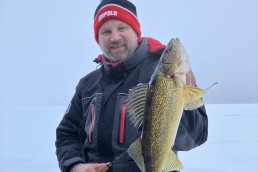Early-Ice: A Great Time for Catching Walleyes
SHARE THIS POST
The great thing about early-ice walleyes is that you don’t have to overthink it.
When it comes to catching walleyes throughout the year, a few times really shine. Early ice is certainly one of those times. Walleyes, being relatively cold-water fish, are still eager to eat during the early-ice season. So, when you drill your holes and get setup on classic walleye structure on your first ice fishing trip of the year, be prepared to set the hook more than once. It is the special time of the year when a significant percentage of the fish that show up on your electronics actually bite.
However, early ice requires a balance of safety and determination. Safety should always win the battle here as no walleye is worth risking your life for. Just be smart about it, go in numbers and be prepared with essential safety gear, such as an ice spud, rope, ice picks and clothing that will float. Ice suits with built-in flotation are well worth the investment, such as the StrikeMaster SOS flotation technology found in their pro and surface sets. When both the jacket and bibs are worn, they provide up to 2 hours of flotation to help you in an emergency.
Once you get out to your hotspot, the great thing about early-ice walleyes is that you don’t have to over think it. Jigging spoons with a minnow head, Jigging Raps, a plain minnow on a hook, a plain minnow on a jig—all work just fine. As the season progresses, the bite window usually gets closer to dark and will actually decrease in duration. However, during early ice, be prepared to stay out there well after sunrise for the morning bite, and to go well before sundown for the evening bite.
Main-lake points that extend out into the basin, humps and deeper flats are all good places to seek out. Try to target depths anywhere from 20 to 35 feet deep for clear-water lakes, and 15 to 25 feet for stained-water lakes. If you are unfamiliar with a particular lake, do a little research ahead of time by looking at online depth references such as Navionics.com or state Department of Natural Resources hydrographic (depth) lake maps. These will give you options to finding suitable structure but will not always be accurate. They give you a good idea of the structure that may be present in the lake, but you will have to drill a lot of holes to make sure that you are where you want to be.
Are you enjoying this post?
You can be among the first to get the latest info on where to go, what to use and how to use it!
For better depth accuracy, look at using electronics with a built-in GPS. For instance, Humminbird Helix units also accept LakeMaster lake map chips to give you as good as 1-foot lake contours on most walleye fisheries. This gives you incredible accuracy to be able to find a suitable fishing spot without having to drill a bunch of holes. Most of the major brands offer this technology to help anglers save time.
If you are planning a walleye trip, try to set one up earlier in the season rather, than later, if you are hoping to ensure success. Plan on walking out to the first-available walleye structure on the lake. The good news is, this time of the year, there usually isn’t much snow, and the advancement in technology, such as lithium batteries, really helps lighten the load in electronics as well as augers. It makes sense to pack light, go in a small group and plan to share as much gear as possible. Once you experience the action of first ice, you won’t want to miss it.
If you enjoy walleye fishing, you’ll find plenty of helpful walleye fishing insight in every issue of MidWest Outdoors. Subscribe on our website.
MWO
SHARE THIS POST
You may also like...
Nothing found.
Did you enjoy this post?
You can be among the first to get the latest info on where to go, what to use and how to use it!
Steve Mattson
Steve Mattson has been writing articles for MidWest Outdoors since 2001. He is a driven angler, guide and sponsored tournament pro who has won both bass and panfish tournaments, and has placed in walleye and pike events. He resides in northern Minnesota and enjoys helping others catch more fish. For more info: mattsonangling.com and @mattsonangling.
